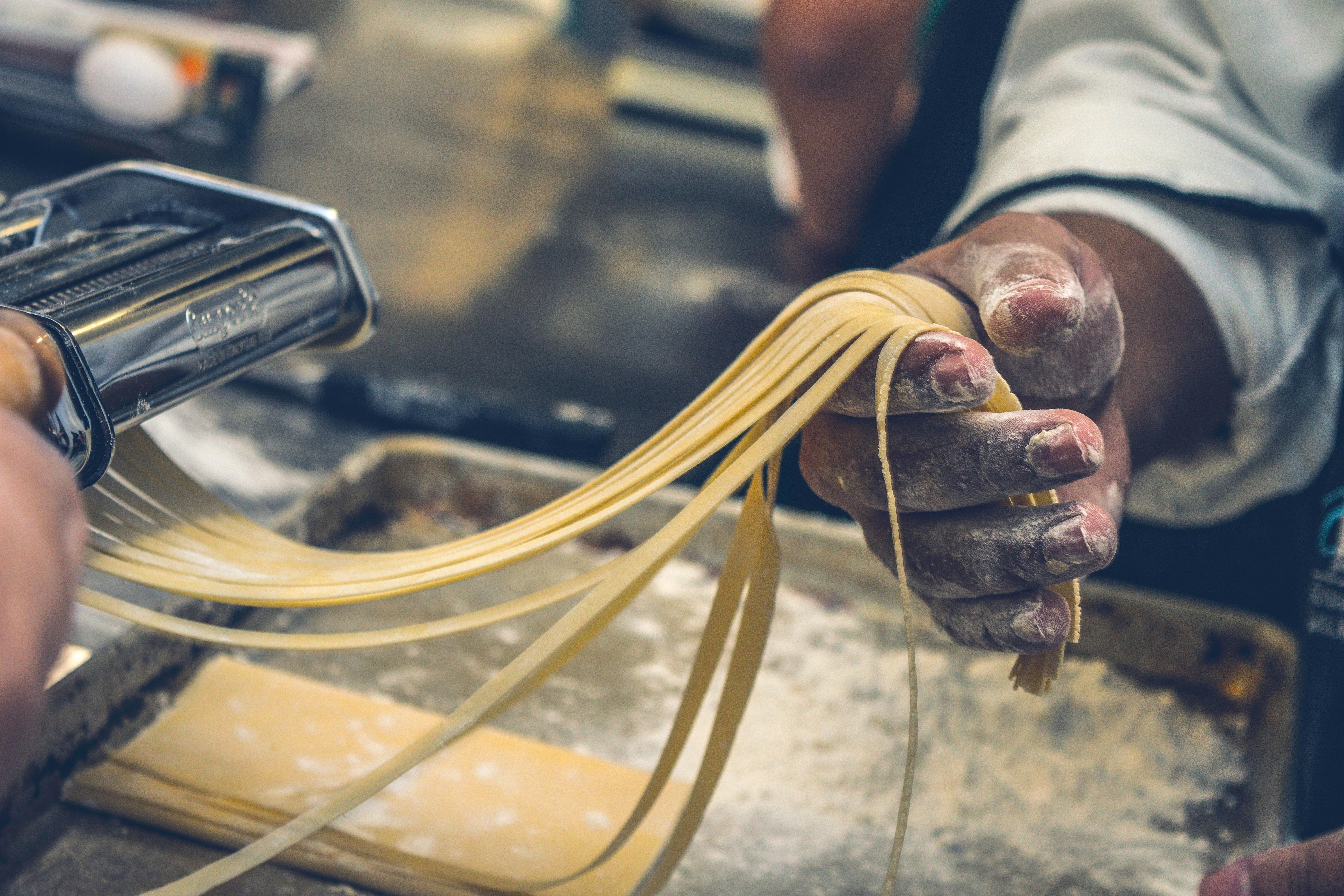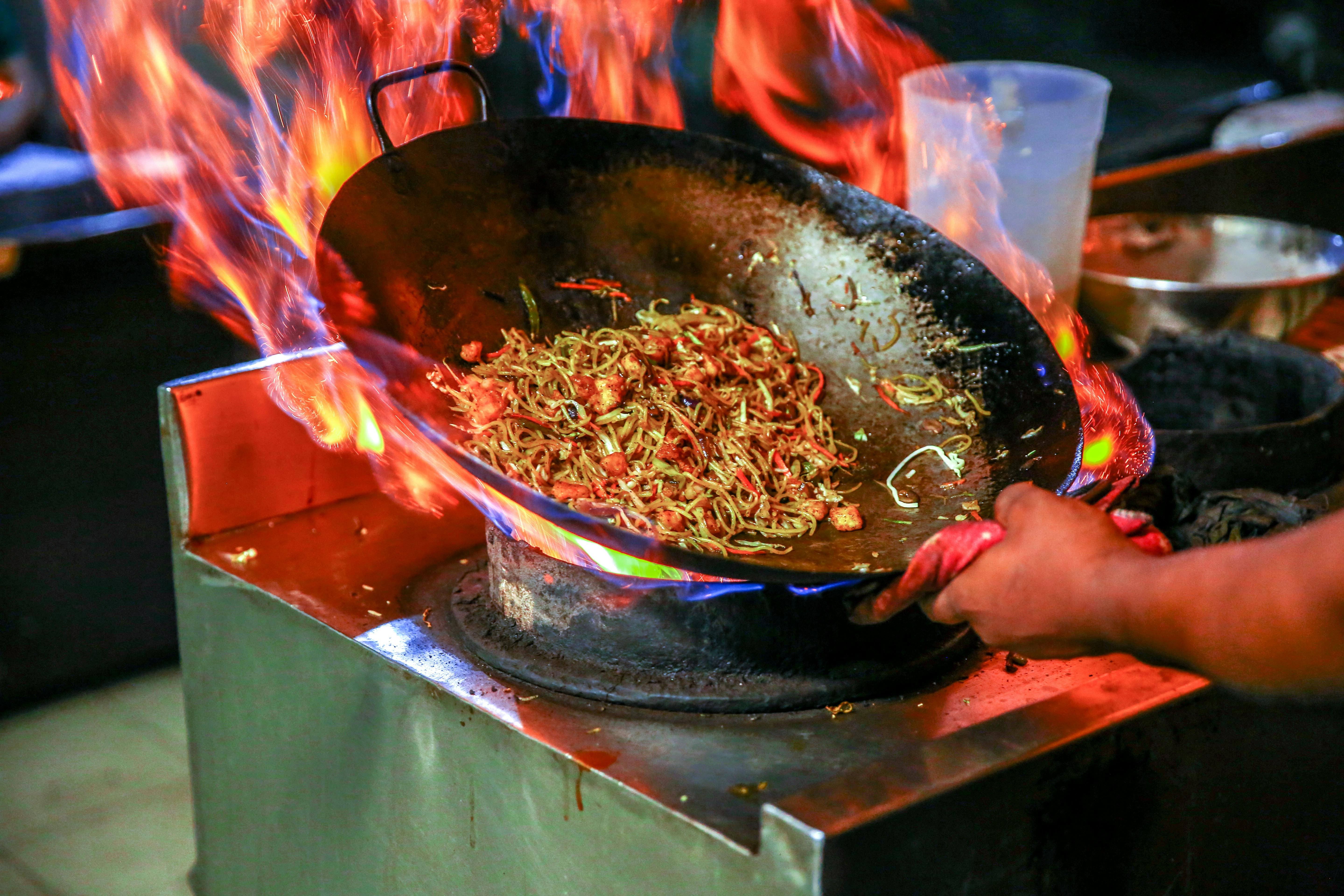如何煮出完美的面条:家庭厨师的专家指南
说实话,我第一次尝试从零开始做面条的时候,完全搞砸了。我的面团硬得像靴子,面条都粘成一团(简直是灾难)。我记得当时心想:“怎么才能在家里做出这种丝滑有弹性的口感呢?” 多年以后,在意大利观察了第四代意面师傅的做法,向曼谷的街头小贩学习,还在自己的厨房里熬了无数个深夜试做之后,我发现了一个有趣的现象。“完美”的面条并非神话。它们是一门科学——也是一门不断发展的艺术,你需要通过不断实践、犯错和品尝来掌握。而这正是我们今天要探讨的——如何做出完美的面条,无论你的技术水平、厨房风格或烹饪风格如何。
为什么现在这很重要?嗯,考虑到2024年家庭烹饪的兴起、全球旅行的中断以及食品价格的上涨1越来越多的人渴望烹饪“美味”,而不必为了一碗拉面而花费$30。而且,说实话,商店买的面条味道很少一样。自己动手做面条,有一种文化魔力(没错,还有科学原理)。
所以,我保证:在本指南中,你将获得久经考验的技巧、简单的科学知识(我发誓,没有专业术语)、真实的文化见解以及超级实用的真正步骤,而不仅仅是美食博客里的空谈。无论你是在尝试破解你的第一包面粉,还是在追逐那道弹牙的意大利美食,你都能找到你想要的——而且我会指出我自己的错误,以便你避免它们!
为什么要自己做面条?
我只想坦白说——自制面条可能让人望而生畏。人们觉得它很繁琐,可能太费力。但让我们先等等。何必呢?就我个人而言,真正让我着迷的是它的味道:劲道、细腻、新鲜,而且完全满足,这是包装食品无法比拟的。当你掌控整个过程——从面粉的选择到最后的成品——你就能掌控自己喜欢的口味、弹性和“吸溜感”。
面条也蕴含着怀旧的元素。对很多人来说,面条能唤起强烈的食物记忆——想想奶奶的擀面杖,或者唐人街那碗无可比拟的手工拉面。正如食物人类学家肯·阿尔巴拉 (Ken Albala) 指出的那样,做面条的仪式实际上能建立联系、家庭和传统。2.
但这并非全是浪漫的缘故。其中也有一些实际(和生态)的原因:
- 控制成分质量——不含奇怪的防腐剂或人工添加剂。
- 定制:选择无麸质、全谷物、富含蛋白质,甚至可以在面团中添加蔬菜!
- 成本:除了初始设备之外,在家做面条的成本非常低廉。
- 可持续性:更少的塑料包装,更少的运输,更多的本地采购(特别是如果你从附近的工厂购买)。
完美面条背后的科学
说到这儿,就有点儿眼熟了——不过听我说,这都是些实用的东西。面条完美的关键在于面筋的形成和水分的吸收。三年前,在尝试调整水化比例之前,我的面条经常会变得很白。是什么改变了这一切?我了解到“嚼劲”来自于优化面粉中的蛋白质结构,以及平衡适量的水、揉面和静置时间。
通俗地说:
麸质 (小麦中的蛋白质基质)是赋予面条弹性的关键。麸质过少,面条会散开。过量,面条就会变得像橡胶一样。影响麸质的因素包括:
- 面粉类型(AP、00、粗面粉、面包、大米、荞麦或混合物)。
- 水合率(水相对于面粉重量的百分比)。
- 揉捏方法(手工、机器、折叠)。
- 静置时间(让面筋“放松”以便于滚动)。
4
我又犯了两个技术错误(而且经常见到):面团搅拌过度,导致面团变硬;静置不足,导致面团太有弹性,擀不薄。这点可以稍微摸索一下。正如我所说,完美是通过实践获得的。
关键成分和基本工具
好吧,让我们退一步,拆开这个工具箱。尤其是在Instagram和精美食谱的盛行下,人们很容易把事情复杂化。但令人惊讶的是:大多数经典面条只需要3-4种厨房必备食材。就是这样。
面粉的种类:这就是个人偏好与当地习俗碰撞的地方。意大利人喜欢“00”的丝滑口感,而荞麦面爱好者则对荞麦粉情有独钟。说实话——由于方便,我70%的时间都用小麦面条,但为了更浓郁的坚果味,我也会尝试用粗粒小麦粉,甚至斯佩耳特小麦粉。如果你不吃麸质,大米粉或木薯粉会是你的好朋友。
水:温度和矿物质含量比人们意识到的更重要。在水质较软的地区(例如日本大部分地区),面条煮得更快,而且更有弹性。
盐:传统的意大利面食通常不加盐,但亚洲面条食谱却依赖盐来调味和构造。
鸡蛋(可选):用来做更浓郁、金黄的意大利面条(比如宽面条或宽面条)。我以前觉得鸡蛋是必不可少的,直到我北京的朋友向我展示了双料面条的妙用。
其他插件: 菠菜、甜菜根汁、墨鱼汁(用于调色),或者偶尔加一点碱性“碱水”来增加拉面的弹性。
让我们来认真谈谈装备。我的必备装备:
- 大型、重型搅拌碗(玻璃或不锈钢)
- 木板或硅胶垫
- 擀面杖(法式擀面杖、直式擀面杖,必要时甚至可以用酒瓶!)
- 锋利的刀或面食切刀
- 漏勺或蜘蛛网
- 可选:面条机(说实话,可以缓解手腕疼痛)
在中国,最早的面条证据来自喇家考古遗址发现的一个有 4000 年历史的碗,它由两种小米制成,比意大利面食早了近两千年!5
有些人信誓旦旦地推荐使用特制的晾衣架或精致的“面条板”。当然有用,但别让装备焦虑阻碍你。我经常会即兴发挥,用一根干净的扫帚柄平衡在两把椅子之间——说实话,这正是它的魅力所在。
探索全球面条传统
事实是:做面条并没有“唯一正确”的方法。不同的文化发展出了各自独特的做法,而我最大的收获就是在各种文化之间交流。让我来重点介绍一下影响本文食谱的几个传统:
- 意大利面食:用00号面粉,有时用鸡蛋,面团很硬。少用水;多揉面、折叠。干意面?又一整套!6
- 中式拉面:高筋小麦粉,加水,用手反复拉伸咀嚼。加盐,有时加碱性剂,以增加口感。7
- 日式荞麦面/乌冬面:荞麦面用的是荞麦,由于荞麦面筋含量低,制作起来比较棘手;通常会与小麦混合。乌冬面则富有弹性,口感厚实,揉面过程也比较用心。8
- 东南亚米粉:完全不含麸质;采用面糊制作方法,通常采用蒸或挤压的方式。9
除了地域性之外,面条的“用途”也很重要。汤面切得更细,以便吸收汤汁;炒面耐高温;而馅料面条(比如馄饨)则需要薄而柔韧的面皮。
需要直观的视觉效果吗?这里有一个表格,比较了全球最受欢迎的面条种类,你可以根据心情或购物清单来选择你的冒险方式:
| 姓名 | 主要成分 | 质地 | 最佳用途 |
|---|---|---|---|
| 新鲜意大利宽面条 | 00 面粉,鸡蛋 | 温柔、柔软 | 奶油酱 |
| 中式拉面 | 小麦粉、水、盐 | 耐嚼,有弹性 | 汤类、炒菜 |
| 日本荞麦面 | 荞麦、小麦 | 坚果味,略硬 | 冰镇酱汁、肉汤 |
| 泰国米粉 | 米粉、水 | 滑溜、柔软 | 泰式炒河粉、越南粉 |
我还记得在京都的一个工作坊里,荞麦面工匠们为面团厚度的几毫米而争论不休——每个传统都是一个独立的世界。
10

一步一步:通用大师面条食谱
好了——准备好迎接精彩内容了吗?这是我多年来在沾满面粉的双手和厨房里各种棘手问题中摸索出来的通用面条配方。它可以无限调整(见文末的修改)。记住:“完美”源于勇于失败和学习。
基本食谱(3-4人份):
- 2 杯(250 克)通用面粉或 00 号面粉(或您选择的面条面粉)
- 约 2/3 杯(150 毫升)水(根据面粉和湿度增减)
- 1/2茶匙盐
- 可选:1 个鸡蛋(如果使用,则省略 35 毫升水),用于制作更浓郁的意大利风味面条
- 制作面团: 将面粉堆在干净的案板上,在中间戳一个深坑。撒上盐。一点一点地加水(如果用鸡蛋,也加一点),用叉子或手指将面粉揉进面团,直到形成一个粗糙蓬松的面团。如果面团看起来很干,不要慌!盖上盖子,静置5分钟——面粉会吸水变软。
- 揉: 用手掌根部按压、折叠和旋转面团7-10分钟。面团应该变得光滑、有弹性,并且略微有点粘。太粘?撒上更多面粉。太干?沾湿手掌,再次揉捏。
- 休息: 把面团裹起来或盖起来,让它静置至少30分钟(即使一个小时也可以)。静置是必须的——静置可以让面筋松弛,更容易擀开。11
- 推出: 将面团分成几份,从中心向外擀平。撒上面粉防粘。大多数面条的厚度以1-2毫米为宜。
- 切: 将面皮卷成松散的长条状,切成所需的宽度(拉面2毫米,宽面最多1厘米)。如果面条较短,则横向切开。
- 干燥(可选): 将面条放在撒了面粉的表面上或悬挂 15-30 分钟;如果潮湿,则撒上更多面粉。
- 厨师: 放入加了大量盐的沸水(如果是拉面/荞麦面,则无需加盐),搅拌,2-4分钟后尝一下。面条应该软烂有嚼劲。
如何调味和着色: 用菠菜汁、甜菜根汁或胡萝卜汁代替10-15%的水,就能做出色泽鲜艳的面条。还可以加点墨鱼汁、姜黄,甚至抹茶,增添风味。
对于无麸质变体: 试试米粉和木薯粉的混合。加更多水,省去揉面步骤,小心擀开。烹饪时间因人而异——需要多尝试几次,但绝对值得。12
像专业人士一样煮面条:水、盐和时间
别忽视锅的作用。从软烂无味的面条到餐厅级别的“劲道”面条,关键就在于煮面的水(哈哈!)。做意大利面时,要像海盐一样加盐(除非你做的是亚洲风味,水里少放盐甚至不放盐),每磅面至少要加4-5升水,以防粘连。我以前习惯撇去水面——这可是个坏主意。另外,煮面的前30秒要搅拌一下(防止结块),而且要根据口味来决定,而不是只看时间。
这是一个简单的烹饪时间表:
| 面条类型 | 新鲜的 | 干的 | 最优测试 |
|---|---|---|---|
| 鸡蛋面 | 2–3分钟 | 6–8分钟 | 柔软,略有弹性 |
| 小麦面条 | 3–4分钟 | 7–10分钟 | 耐嚼,不粘 |
| 米粉 | 2–5分钟 | 8–12分钟 | 半透明,滑溜 |
提示: 留一杯淀粉煮水,最后用来调整酱汁。意大利老奶奶和专业厨师都信誓旦旦地推荐这个,她们说得没错。13
14
另外,煮熟后不要冲洗(大多数面条都适用)——除非你准备的是凉拌菜,否则会冲走味道。炒菜的话,用冷水快速“冲洗”一下,会停止煮熟,而且口感会比较滑。
点睛之笔:酱汁搭配及食用建议
此刻,你已经做好了一堆闪闪发光的完美面条。别就此止步!你收尾的方式会让这道菜从“足够好”提升到“令人难忘”。根据我的经验,关键在于 匹配面条类型、酱汁浓度和最终配料:
- 粗切意大利面条: 最适合搭配慢炖的肉酱或粘稠的蘑菇酱。
- 细小麦面或鸡蛋面: 淡橄榄油、柠檬皮或快煮的蔬菜突出了它们的口感。
- 米粉: 非常适合搭配辛辣汤底(越南粉)或酸味罗望子炒菜(泰式炒河粉)。
- 冷荞麦面: 搭配日式高汤、葱、芥末和少许烤芝麻,享受夏日禅意。
别忘了文化乐趣——在日本,吸溜吃东西不仅被接受,还被认为是对厨师的一种赞美15与此同时,意大利奶奶可能会因为你在汤里旋转而对你侧目。背景和乐趣很重要。
如何储存和重新加热自制面条
我以前浪费了很多面条,因为我提前好几天就准备好了晚宴食材,却没有意识到储存面条本身也是一门技术。真正有帮助的方法是:
- 将新鲜切好的面条撒上额外的面粉,卷成窝状,然后放入密封容器中冷藏长达 48 小时。
- 将未煮熟的面条分成几份放在托盘上冷冻;待其凝固后装袋即可。冷冻后即可烹饪,无需解冻。
- 煮熟的面条应快速冷却,用少量中性油搅拌,冷藏最多 3 天,然后在沸水或肉汤中轻轻加热。
16
常见的面条问题(以及人性化的答案)
- 问: 我可以不用机器做面条吗?
一个: 当然可以——手揉面团不仅能让你拥有触觉,还能更好地感受面团的韧性。话虽如此,机器揉面更省时间,而且也不算“作弊”。充分利用你手头现有的资源吧。 - 问: 如何避免面条变得糊状?
一个: 加足水,提前测试,不要煮过头。新鲜面条比干面条煮得快得多。13 - 问: 做面条用什么面粉最好?
一个: 对于意大利风味来说,“00” 就很棒,但用途广泛,万能的也适用。对于喜欢嚼劲的亚洲人,请选择高蛋白/面包粉。 - 问: 我可以将其素食化吗?
一个: 当然可以——只要不加鸡蛋,多加点水或少许橄榄油就可以了。
参考



